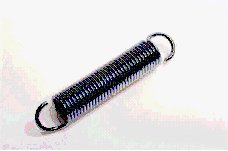Course content > Newton's Laws > Kinds of Forces > Springs
Prerequisites
|
Consider the spring shown in the figure. Its resting length is 5 cm. Consider that a pair of equal and opposite forces of magnitude, T, are exerted on the two ends of the spring, pulling or pushing in opposite directions. If T is positive, it means the forces are pulling to try to stretch the spring. If T is negative, it means they are trying to compress the spring.
We typically model the relation between the tension and the stretch by Hooke's law, T = ΔL,the stretch is proportional to the pull. But for a real spring like the one shown here, it's pretty clear that the simple Hooke model won't hold for very long. Let's try so see how it might really look.
|
|
|
|
Let's sketch a graph of how the length of the spring varies as a function of T, considering both positive and negative values of T and going to very large values.
The spring shown looks pretty stiff and is tightly coiled. This means that if I try to compress it (use a negative tension), there is no loose space between the coils to compress. As I start to press, I immediately encounter what is basically a solid block of steel. Any forces I can exert, even with lab equipment I might reasonably expect to get my hands on would result in no measurable reduction in the length of the spring. This is represented in the graph as region I. Increasing force (squeeze) does not significantly measurably change the length.
|
When I start pulling on the spring, it begins to stretch, the coils opening out. The metal is deforming very little in order to produce some opening between the coils. This is the region we usually describe by Hooke's Law: the stretch is proportional to the tension. I would expect to be able to pull the spring out to about twice its length before I started having to deform the coils. This is represented in the graph as region II.
Once I get beyond that length, I have to start deforming the coils. I expect that this will take more force per extra bit of extension since I am starting to really deform the metal. This region may not be a straight line but I will draw it that way until I get some real data. How far can I stretch it? When I have stretched it fully out, I will have basically a single uncoiled straight wire. The coil seems to have about 30 rings and its diameter is about 1/5 of its length, 1 cm. This means each ring has a length of about 3.14 cm so the total length of the spring when uncoiled should be about 100 cm. This is shown in region III.
When the wire is completely uncoiled, it is very hard to stretch it any further. If I pull harder and harder, eventually I reach the "plastic zone" where the metal suddenly stretches and then breaks. (Some materials will just break, without this final stretching.) This is shown in region IV and the break indicated by an X.

